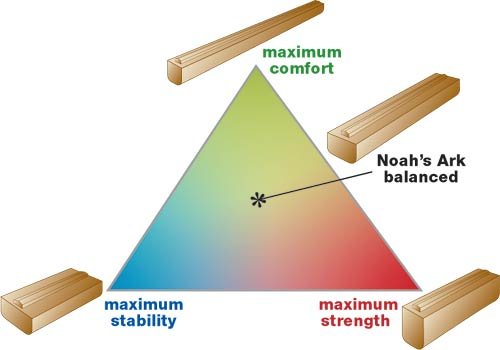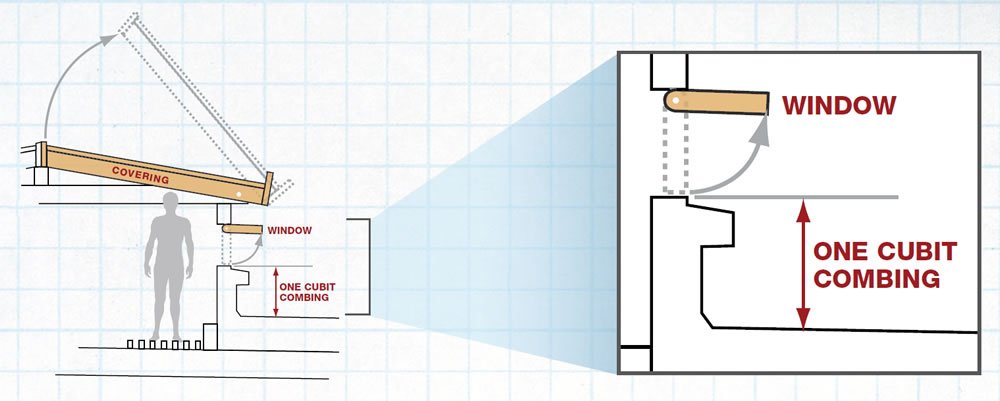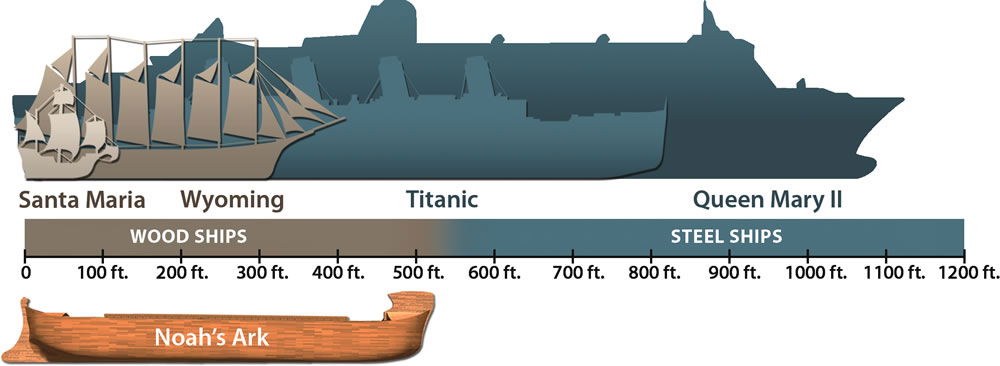Thinking Outside the Box
While the Bible gives us essential details on many things, including the size and proportions of Noah’s Ark, it does not necessarily specify the precise shape of this vessel. It is important to understand, however, that this lack of physical description is consistent with other historical accounts in Scripture.1 So how should we illustrate what the Ark looked like? The two main options include a default rectangular shape reflecting the lack of specific detail, and a more fleshed-out design that incorporates principles of ship design from maritime science, while remaining consistent with the Bible’s size and proportions.
Genesis describes the Ark in three verses, which require careful examination:
6:14—“Make yourself an ark [tebah] of gopher wood; make rooms [qinniym] in the ark, and cover it inside and outside with pitch [kofer].
6:15—“And this is how you shall make it: The length of the ark shall be three hundred cubits, its width fifty cubits, and its height thirty cubits.
6:16—“You shall make a window [tsohar] for the ark, and you shall finish it to a cubit from above; and set the door of the ark in its side. You shall make it with lower, second, and third decks” (NKJV).
Most Bibles make some unusual translation choices for certain key words. Elsewhere in the Bible the Hebrew word translated here as “rooms” is usually rendered “nests”; “pitch” would normally be called “covering”; and “window” would be “noon light.” Using these more typical meanings, the Ark would be something like this:
The tebah (Ark) was made from gopher wood, it had nests inside, and it was covered with a pitch-like substance inside and out. It was 300 cubits long, 50 cubits wide, and 30 cubits high. It had a noon light that ended a cubit upward and above, it had a door in the side, and there were three decks. (For the meaning of “upward and above,” see point #2 on the diagram below.)
As divine specifications go, Moses offered more elaborate details about the construction of the Tabernacle, which suggests this might be the abridged version of Noah’s complete directions. On the other hand, consider how wise Noah must have been after having lived several centuries. The instructions that we have recorded in Genesis may be all he needed to be told. But in any case, 300 cubits is a big ship, not some whimsical houseboat with giraffe necks sticking out the top.
Scripture gives no clue about the shape of Noah’s Ark beyond its proportions—length, breadth, and depth. Ships have long been described like this without ever implying a block-shaped hull.
The scale of the Ark is huge yet remarkably realistic when compared to the largest wooden ships in history. The proportions are even more amazing—they are just like a modern cargo ship. In fact, a 1993 Korean study was unable to find fault with the specifications (see sidebar “Scientific Study Endorses Seaworthiness of Ark” below).
All this makes nonsense of the claim that Genesis was written only a few centuries before Christ, as a mere retelling of earlier Babylonian flood legends such as the Epic of Gilgamesh. The Epic of Gilgamesh story describes a cube-shaped ark, which would have given a dangerously rough ride. This is neither accurate nor scientific. Noah’s Ark is the original, while the Gilgamesh Epic is a later distortion.
Scientific Study Endorses Seaworthiness of Ark
The proportions of the Ark were found to carefully balance the conflicting demands of stability, comfort, and strength.

Noah’s Ark was the focus of a major 1993 scientific study headed by Dr. Seon Hong at the world-class ship research center KRISO, based in Daejeon, South Korea. Dr. Hong’s team compared twelve hulls of different proportions to discover which design was most practical. No hull shape was found to significantly outperform the 4,300-year-old biblical design. In fact, the Ark’s careful balance is easily lost if the proportions are modified, rendering the vessel either unstable, prone to fracture, or dangerously uncomfortable.
The research team found that the proportions of Noah’s Ark carefully balanced the conflicting demands of stability (resistance to capsizing), comfort (“seakeeping”), and strength. In fact, the Ark has the same proportions as a modern cargo ship.

The study also confirmed that the Ark could handle waves as high as 100 ft (30 m). Dr. Hong is now director general of the facility and claims “life came from the sea,” obviously not the words of a creationist on a mission to promote the worldwide Flood. Endorsing the seaworthiness of Noah’s Ark obviously did not damage Dr. Hong’s credibility.
Dr. Seon Won Hong was principal research scientist when he headed up the Noah’s Ark investigation. In May 2005 Dr. Hong was appointed director general of MOERI (formerly KRISO). Dr. Hong earned a B.S. degree in naval architecture from Seoul National University and a Ph.D. degree in applied mechanics from the University of Michigan, Ann Arbor.
Source: worldwideflood.com/ark/hull_form/hull_optimization.htm
What About the Shape?
For many years biblical creationists have simply depicted the Ark as a rectangular box. This helped emphasize its size. It was easy to explain capacity and illustrate how easily the Ark could have handled the payload. With the rectangular shape, the Ark’s stability against rolling could even be demonstrated by simple calculations.
Yet the Bible does not say the Ark must be a rectangular box. In fact, Scripture does not elaborate about the shape of Noah’s Ark beyond those superb, overall proportions—length, breadth, and depth. Ships have long been described like this without implying a block-shaped hull.
In Hebrew “Ark” is the obscure term tebah, a word that appears only one other time when it describes the basket that carried baby Moses (Exodus 2:3). One was a huge, wooden ship and the other a tiny, wicker basket. Both floated, both preserved life, and both were covered; but the similarity ends there. If the word implied anything about shape, it would be “an Egyptian basket-like shape,” typically rounded. More likely, however, tebah means something else, like “lifeboat.”2
The Bible leaves the details regarding the shape of the Ark wide open—anything from a rectangular box with hard right angles and no curvature at all, to a shiplike form. Box-like has the largest carrying capacity, but a ship-like design would be safer and more comfortable in heavy seas. Such discussion is irrelevant if God intended to sustain the Ark no matter how well designed and executed.
Clues from the Bible
Some question whether the Ark was actually built to handle rough seas, but the Bible gives some clues about the sea conditions during the Flood:
- The Ark had the proportions of a seagoing vessel built for waves (Genesis 6:15).
- Logically, a mountain-covering, global flood would not be dead calm (Genesis 7:19).
- The Ark moved about on the surface of the waters (Genesis 7:18).
- God made a wind to pass over the earth (Genesis 8:1).
- The Hebrew word for the Flood (mabbul) could imply being carried along.
The 1993 Korean study showed that some shorter hulls slightly outperformed the Ark model with biblical proportions (see sidebar “Scientific Study Endorses Seaworthiness of Ark” above). The study assumed waves came from every direction, favoring shorter hulls like that of a modern lifeboat. So why was Noah’s Ark so long if it didn’t need to be streamlined for moving through the water?
The answer lies in ride comfort (seakeeping). This requires a longer hull, at the cost of strength and stability, not to mention more wood. The Ark’s high priority for comfort suggests that the anticipated waves must have been substantial.
Designed for Tsunamis?
Was the Ark designed for tsunamis? Not really. Tsunamis devastate coastlines, but when a tsunami travels in deep water, it is almost imperceptible to a ship. During the Flood, the water was probably very deep—there is enough water in today’s oceans to cover a relatively flat earth to a consistent depth of over 2 miles (3.2 km). The Bible states that the Ark rose “high above the earth” (Genesis 7:17) and was stranded early (Genesis 8:4), before mountaintops were seen. If the launch was a mirror of the landing—the Ark being the last thing to float—it would have been a deep-water voyage from start to finish.
A cubit upward and above

Any opening on the deck of a ship needs a wall (combing) to prevent water from flowing in, especially when the ship rolls. In this illustration, the window “ends a cubit upward and above,” as described in Genesis 6:16. The central position of the skylight is chosen to reflect the idea of a “noon light.” This also means that the window does not need to be exactly one cubit. Perhaps the skylight had a transparent roof (even more a “noon light”), or the skylight roof could be opened (which might correspond to when “Noah removed the covering of the Ark”). While variations are possible, a window without combing is not the most logical solution.
The worst waves may have been caused by wind, just like today. After several months at sea, God made a wind to pass over the earth. This suggests a large-scale weather pattern likely to produce waves with a dominant direction. It is an established fact that such waves would cause any drifting vessel to be driven sideways (broaching). A long vessel like the Ark would remain locked in this sideways position, an uncomfortable and even dangerous situation in heavy weather.
However, broaching can be avoided if the vessel catches the wind at one end and is “rooted” in the water at the other—turning like a weather vane into the wind. Once the Ark points into the waves, the long proportions create a more comfortable and controlled voyage. It had no need for speed, but the Ark did “move about on the surface of the waters.”
Mortise and tenon planking
Ancient shipbuilders usually began with a shell of planks (strakes) and then built internal framing (ribs) to fit inside. This is the complete reverse of the familiar European method where planking was added to the frame. In shell-first construction, the planks must be attached to each other somehow. Some used overlapping (clinker) planks that were dowelled or nailed, others used rope to sew the planks together. The ancient Greeks used a sophisticated system where the planks were interlocked with thousands of precise mortise and tenon joints. The resulting hull was strong enough to ram another ship, yet light enough to be hauled onto a beach by the crew. If this is what the Greeks could do centuries before Christ, what could Noah do centuries after Tubal-Cain invented forged metal tools?

The box-like Ark is not entirely disqualified as a safe option, but sharp edges are more vulnerable to damage during launch and landing. Blunt ends would also produce a rougher ride and allow the vessel to be more easily thrown around (but, of course, God could have miraculously kept the ship’s precious cargo safe, regardless of the comfort factor). Since the Bible gives proportions consistent with those of a true cargo ship, it makes sense that it should look and act like a ship, too.

Something to catch the wind
Wind-driven waves would cause a drifting vessel to turn dangerously side-on to the weather. However, such waves could be safely navigated by making the Ark steer itself with a wind-catching obstruction on the bow. To be effective, this obstruction must be large enough to overcome the turning effect of the waves. While many designs could work, the possibility shown here reflects the high stems which were a hallmark of ancient ships.
Ramps
Ramps help to get animals and heavy loads between decks. Running them across the hull avoids cutting through important deck beams, and this location is away from the middle of the hull where bending stresses are highest. (This placement also better utilizes the irregular space at bow and stern.)
Something to catch the water
To assist in turning the Ark to point with the wind, the stern should resist being pushed sideways. This is the same as a fixed rudder or skeg that provides directional control. There are many ways this could be done, but here we are reflecting the “mysterious” stern extensions seen on the earliest large ships of the Mediterranean.
Coincidentally, certain aspects of this design appear in some of the earliest large ships depicted in pottery from Mesopotamia, which is not long after the Flood. It makes sense that shipwrights, who are conservative as a rule, would continue to include elements of the only ship to survive the global Flood—Noah’s Ark.

Scripture gives no clue about the shape of Noah’s Ark beyond its proportions that are given in Genesis 6:15, which reads: “And this is how you shall make it: The length of the ark shall be three hundred cubits, its width fifty cubits, and its height thirty cubits” (NKJV).
Scripture does not record direction-keeping features attached to the Ark. They might have been obvious to a 500-year-old, or perhaps they were common among ships in Noah’s day as they were afterwards. At the same time, the brief specifications in Genesis make no mention of other important details, such as storage of drinking water, disposal of excrement, or the way to get out of the Ark. Obviously Noah needed to know how many animals were coming, but this is not recorded either.
The Bible gives clear instruction for the construction of a number of things, but it does not specify many aspects of the Ark’s construction. Nothing in this newly depicted Ark (as seen on the cover) contradicts Scripture, even though it may be different from more accepted designs. But this design, in fact, shows us just how reasonable Scripture is as it depicts a stable, comfortable, and seaworthy vessel that was capable of fulfilling all the requirements stated in Scripture.
Was Noah’s Ark the Biggest Ship Ever Built?
Few wooden ships have ever come close to the size of Noah’s Ark. One possible challenge comes from the Chinese treasure ships of Yung He in the 1400s. An older contender is the ancient Greek trireme Tessarakonteres.
At first historians dismissed ancient Greek claims that the Tessarakonteres was 425 feet (130 m) long. But as more information was learned, the reputation of these early shipbuilders grew markedly. One of the greatest challenges to the construction of large wooden ships is finding a way to lay planks around the outside in a way that will ensure little or no leaking, which is caused when there is too much movement between the planks. Apparently, the Greeks had access to an extraordinary method of planking that was lost for centuries, and only recently brought to light by marine archaeology.
It is not known when or where this technique originated. Perhaps they used a method that began with the Ark. After all, if the Greeks could do it, why not Noah?
The Ark is near the maximum size that is known to be possible for a wooden vessel.
How Big Was the Ark?
It depends on your cubit size! To get the 510 ft (155 m) given here, we used a cubit of 20.4 in (51.8 cm).

This diagram shows how Noah’s Ark compares to other large ships.
Answers Magazine
April – June 2007
Get a fresh look at Noah's Ark, the Global Flood and its impact on the Earth.
Browse IssueFootnotes
- Other objects spoken of in Scripture lack physical details which have been discovered (through archaeology and other research) later (e.g., the walls of Jericho were actually double and situated on a hillside—one higher than the other with a significant space of several feet between them).
- C. Cohen, Hebrew TBH: Proposed Etymologies, The Journal of the Ancient Near Eastern Society (JANES), pp. 36–51, April 1, 1972. New York: Jewish Theological Seminary. (The journal was at that time called The Journal of the Ancient Near Eastern Society of Columbia University, Ancient Near Eastern Society of Columbia University, New York.)

Answers in Genesis is an apologetics ministry, dedicated to helping Christians defend their faith and proclaim the good news of Jesus Christ.
- Customer Service 800.778.3390
- Available Monday–Friday | 9 AM–5 PM ET
- © 2026 Answers in Genesis



